The Activity Module option shows how Kiuwan manages notifications and how to get control over all the users' actions in the Kiuwan account.
Activity Module allows you to register and to get notified by email of all the performed actions in Kiuwan, helping you to record the information of different processes. Below, you can find how to view these actions and how to configure the recipients of the notifications.

Introduction to Activity module
The Activity module can be selected at the top-right drop-down menu.
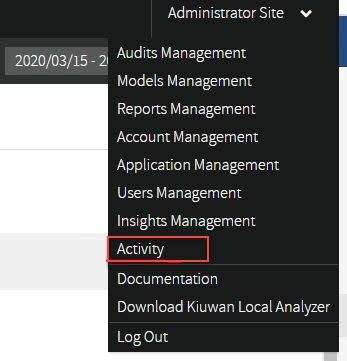
The Activity module contains the following tabs:
- Actions: A list of all the events that have taken place in the system.
Actions
The ACTIONS tab helps you to keep track of all the events related to your Kiuwan account: what, where, when, and who. Use the filters to find specific elements.
Users with admin privileges can see all the events of the system, even those performed by any user of the account. Other users are only allowed to see their own events and those events performed by other users that directly affect them.
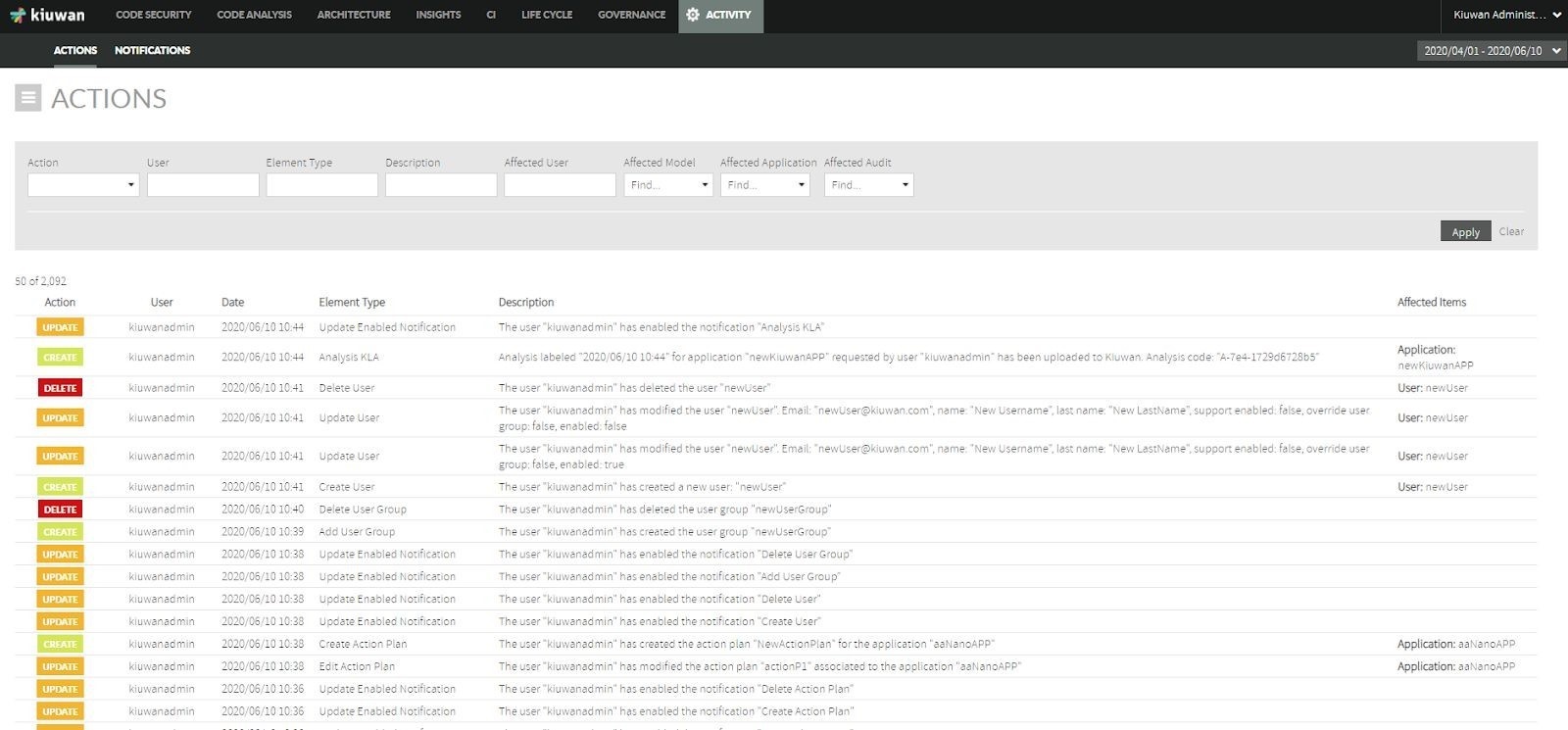
Below, is the detailed information on the ACTIONS tab:
| Name | Description |
|---|
| Action | Short description of the action performed. The actions are the following: ANALYSIS_END, ASSIGN, CREATE, DELETE, DOWNLOAD, EXPORT, GENERATE, IMPORT, LICENSE, LOGIN, LOGOUT, and UPDATE. Each action is represented by different colors to identify them easier. |
| User | The user performs the action. |
| Date | The date when the action is performed. |
| Element Type | Type of action performed. It lists the type of actions, review List of type of actions. |
| Description | The information about the action. |
| Affected Items | User, model, application, or audit affected by this action. |
Notifications
Relevant events in the system generate notifications to be sent to account users. In the NOTIFICATIONS tab, you can see all the listed notifications generated, with their related details.
Users with admin privileges can see all the notifications of the system, those performed by any user of the account. Other users are only allowed to see their own events and those events performed by other users that directly affect them.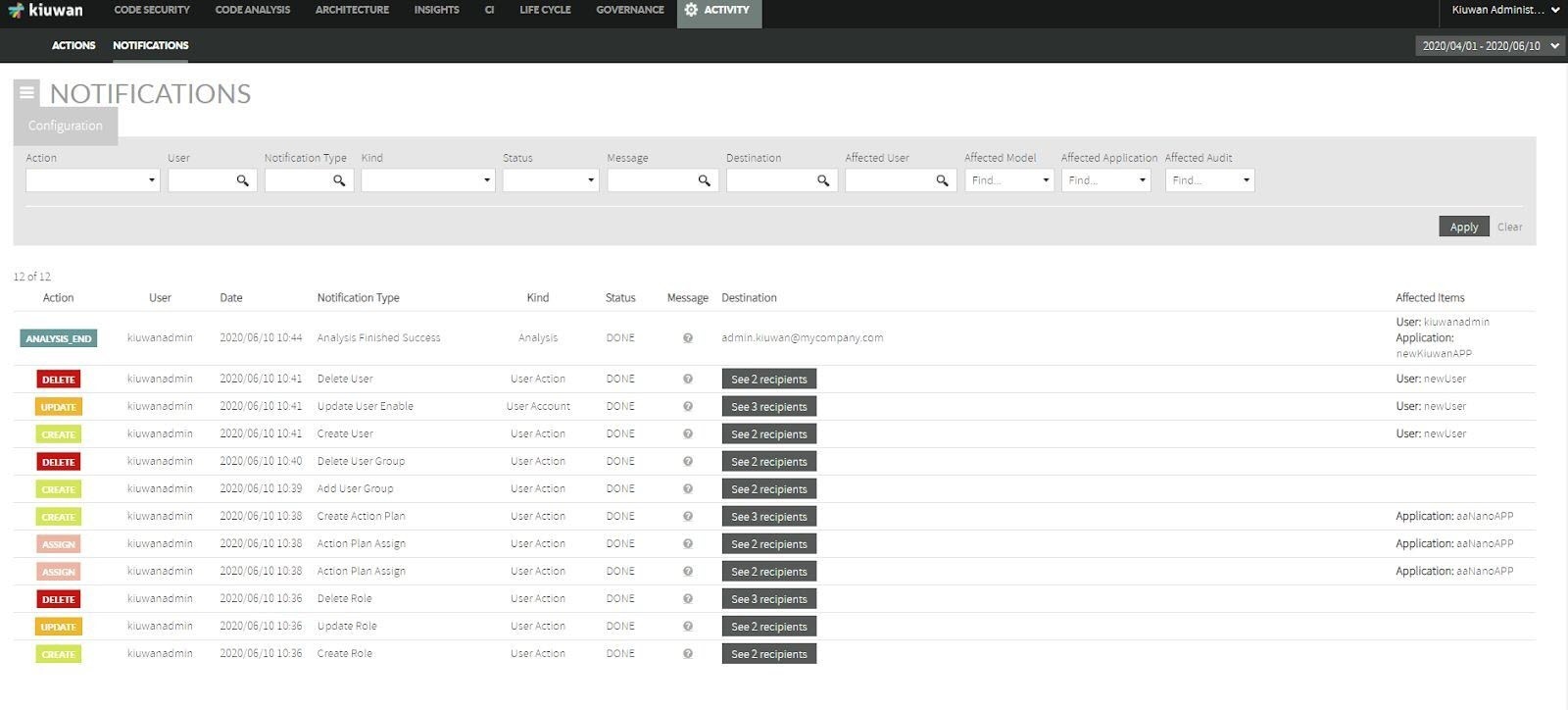
Below, the detailed information of the ACTIONS tab:
| Name | Description |
|---|
| Action | The action that triggers the notification. These actions are the following:
CREATE, DELETE, UPDATE, DOWNLOAD, IMPORT, GENERATE, EXPORT, LICENSE, ANALYSIS_END, and ASSIGN. Each action is represented by different colors to identify them easier. |
| User | The user that performs the notification. |
| Date | The date when the notification is registered. |
| Notification Type | The type of notification. |
| Kind | Functional grouping of notifications are the following: - Analysis: Notifications related to the execution of analysis.
- User Account: Notifications that are user account-related, for example, a disabled account.
- User Action: Notifications that are registered when a user performs different operations in the Kiuwan web or a user invokes API-REST services.
- Insights: Notifications generated by Insights services.
- Subscription: Notifications that are related to a subscription.
|
| Status | Indicates the status of the notification. These statuses can be PENDING, DONE, and ERROR. |
| Message | The sent message to the recipients of the notification. |
| Destination | The email addresses list. |
| Affected Items | The notification fields that are affected. For example, Application, User, Models, Audits. |
When you click See Recipients, the RECIPIENTS window opens. This window displays the recipients' list by User name and mail.

Configurations
Under the top-left corner of the NOTIFICATIONS screen, select Configuration from the drop-down menu.
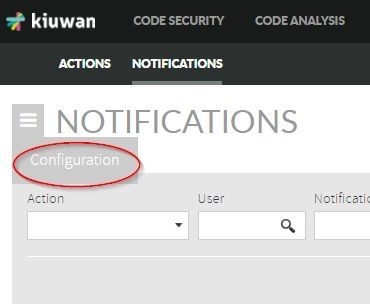
The Configuration screen shows you a list of the type of notifications that Kiuwan provides for the user and the configuration options for each one of them
Only Users with User Management privileges have the Active column enable, having the option to check or uncheck the box under this column and assign a type of notification to users.
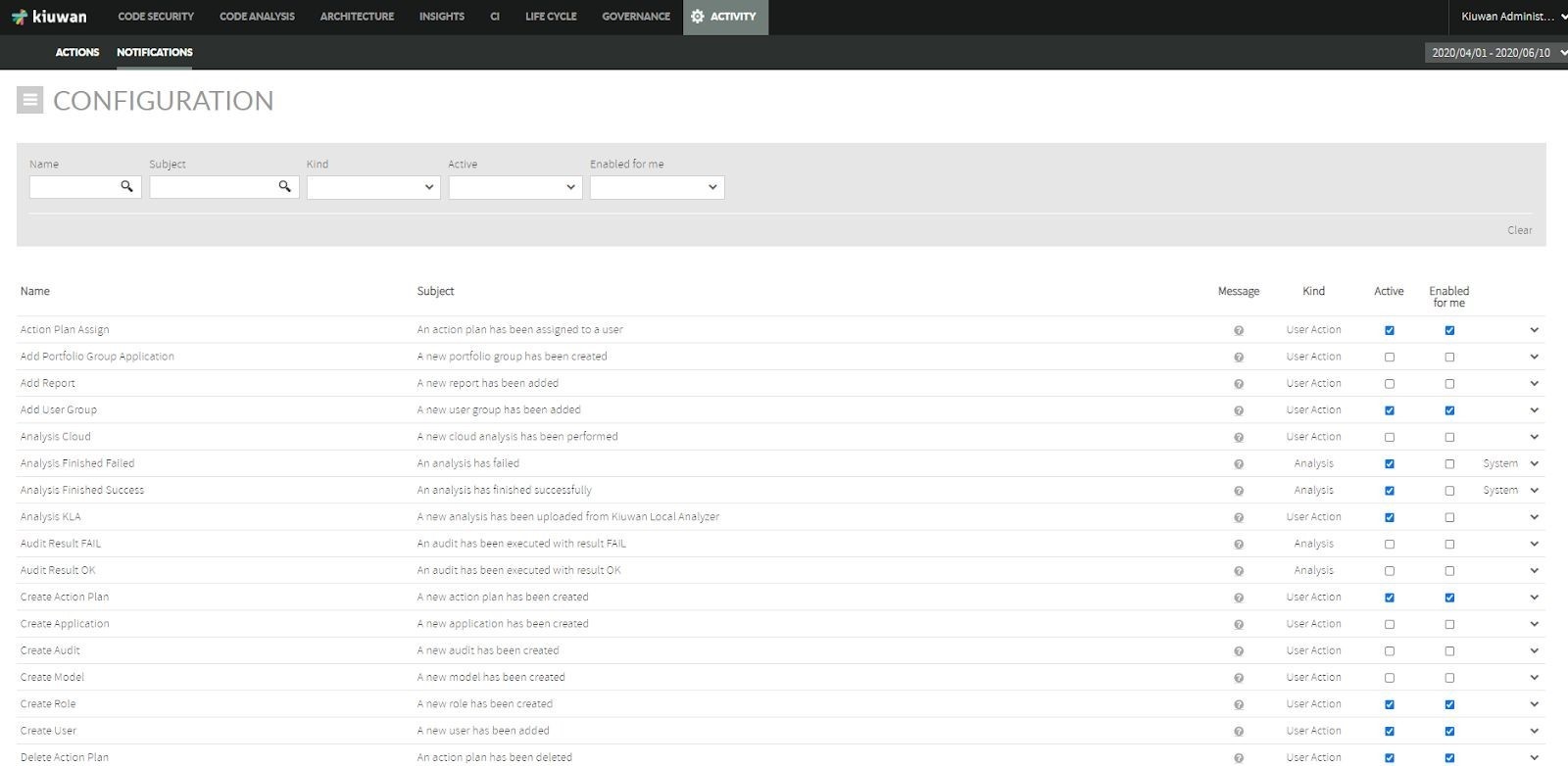
Below, is the detailed information on the CONFIGURATION option:
| Name | Description |
|---|
| Name | Name of the notification. |
| Subject | The subject of the mail that the user receives when the notification is sent. |
| Message | The message that is sent to the recipients. |
| Kind | Functional grouping of notifications are the following: - Analysis: Notifications related to the execution of analysis.
- User Account: Notifications that are user account-related, for example, a disabled account.
- User Action: Notifications that are registered when a user performs different operations in the Kiuwan web or a user invokes API-REST services.
- Insights: Notifications generated by Insights services.
- Subscription: Notifications that are related to a subscription.
|
| Active | Shows if notification is enabled or disabled for all the users. The System notifications have this field checked by default, a user with User Management privileges can enable or disable this notification. When this checkbox is selected, the notification is generated. |
| Enabled for me | Indicated that a notification is enabled or not for the current user. When a user has notifications assigned, they can be enabled or disable despite the privileges of the user. |
| System | The System notifications are generated by Kiuwan automatically. |
Assign type of notifications to different users
Only users with User Management privilege are allowed to assign recipients to a type of notification. Select Type of Notification and open the drop-down menu

The Assign option is enabled when the Active checkbox is selected. |
The Assign window opens when you click the Assign option, which allows you to assign the type of notification to different users.
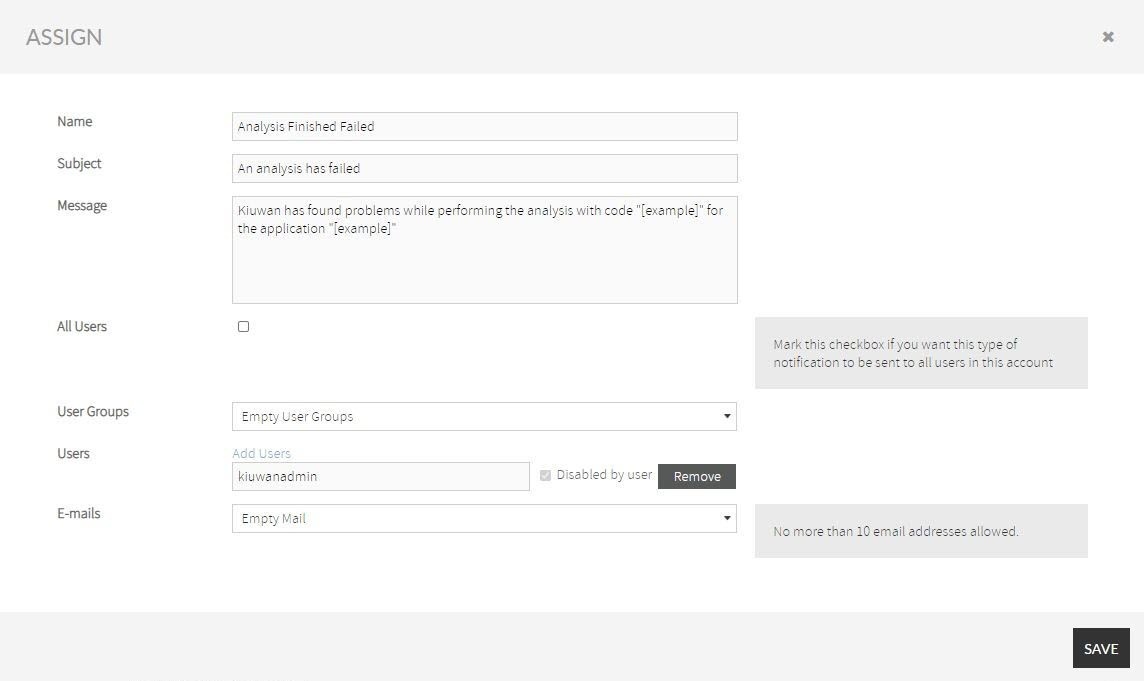
Name | Description |
|---|
Name | Name of the notification. |
Subject | The subject of the mail that the user receives when the notification is sent. |
Message | The message that is sent to the recipients. |
All users | Allows you to add all the users to this type of notification. If the All users checkbox is selected, the User Groups and Users are not used. |
| User Groups | Allows you to add user groups as recipients of this type of notification. |
| Users | When you click Add Users a window opens with a list of users. These users can be added to this type of notification. Also, when a user is added, the remove option displays and if the notification has been disabled by this user. |
| E-mails | Allows you to add up to ten email addresses. |
Permission of type of notification
Each type of notification has a set of permissions defined. These permissions allow you to choose if the notification can be sent or not to a user. There are different types of permissions that a type of notification may require:
- Manage User: When a user has this permission, receives the notification.
- Manage Applications: When a user has this permission, receives the notification.
- Manage Audits: When a user has this permission, receives the notification.
- Manage Models: When a user has this permission, receives the notification.
- Application: When a user has permission for a specific application, receives the notification.
- User: When a user is affected by the notification, receives the notification. For example, the user gets notified if an action plan is assigned to him.
- SuperAdmin: When a user has the SuperAdmin role, receives the notification.
- Owner: When the user has the Owner role, receive the notification.
Conditions for a user to receive a notification
When a user is configured to receive a specific notification, is possible that the mail with this information is not received.
The user should meet the following requirements:
- The user is configured to receive this type of notification.
- The user is enabled.
- The user has the permissions specified for this type of notification.
- The type of notification has the Active checkbox to true.
- The user has not disabled himself from this type of notification.
List of types of notifications
Name notification | Permissions | System |
|---|
Action Plan Assign | Manage Users, User | No |
Add Portfolio Group Application | Manage Applications | No |
Add Report | Manage Reports | No |
Add User Group | Manage Users | No |
Analysis Cloud | Application | No |
Analysis Finished Failed | Application | Yes |
Analysis Finished Success | Application | Yes |
Analysis KLA | Application | No |
Audit Result FAIL | Application | No |
Audit Result OK | Application | No |
Create Action Plan | Application | No |
Create Application | Manage Applications | No |
Create Audit | Manage Audits | No |
Create Model | Manage Models | No |
Create Role | Manage Users | No |
Create User | Manage Users | No |
Delete Action Plan | Application | No |
Delete Application | Application | No |
Delete Audit | Manage Audits | No |
Delete Model | Manage Models | No |
Delete Portfolio Group Application | Manage Applications | No |
Delete Report | Manage Reports | No |
Delete Role | Manage Users | No |
Delete User | Manage Users | No |
Delete User Group | Manage Users | No |
Generate Report | Manage Reports | No |
Insight New Vulnerabilities | Application | Yes |
Limit Analysis by Subscription | Superadmin, Owner | Yes |
Limit Apps | Superadmin, Owner | Yes |
Limit Lines of Code | Superadmin, Owner | Yes |
Limit Login Attempts | Manage Users, User | Yes |
Mute Defects Vulnerabilities | Application | No |
Plan Expire | Superadmin, Owner | Yes |
Publish Audit | Manage Audits | No |
Publish Model | Manage Models | No |
Remove Analysis | Application | No |
Update Mute Defects Vulnerabilities | Application | No |
Update Role | Manage Users | No |
Update User Enable | Manage Users, User | Yes |
 List of type of actions
List of type of actions
Name action |
|---|
Activate Rule Model |
Add Checkpoint Audit |
Add Portfolio Group Application |
Add Report |
Add Secret Key |
Add User Group |
Analysis Cloud |
Analysis KLA |
Change Defects Status |
Change Model Indicators |
Change Password |
Change Password Policy |
Change Privacy Policy |
Change User Accounts Policy |
Change user administration privileges |
Change user permission on application |
Change user permission on portfolios |
Change User Profile |
Classify Application |
Create Action Plan |
Create Application |
Create Audit |
Create Custom Artifact Insight |
Create Custom Vulnerability Insight |
Create Model |
Create Role |
Create User |
Deactive Rule Model |
Delete Action Plan |
Delete Application |
Delete Audit |
Delete Audit Version |
Delete Checkpoint Audit |
Delete Custom Artifact Insight |
Delete Custom License Policy |
Delete Custom Rules JAR |
Delete Custom Vulnerability Insight |
Delete Delivery |
Delete Model |
Delete Model Version |
Delete Mute Defects Vulnerabilities |
Delete Portfolio Group Application |
Delete Report |
Delete Role |
Delete Rule |
Delete Secret Key |
Delete User |
Delete User Group |
Download Custom Config |
Download Custom Rules JAR |
Download KLA |
Edit Action Plan |
Edit Application |
Edit Audit |
Edit Checkpoint Audit |
Edit Model |
Edit Portfolio Group Application |
Edit Report |
Edit Rule |
Execute Impact Analysis |
Export to Threadfix |
Generate Report |
Generate Rules ZIP |
Import Rule Sets |
Install Rule Definitions |
Lock Engine |
Mark User as Owner |
Modify Audit Version Tag |
Modify Licenses Policies |
Modify Model Application |
Modify Model Version Tag |
Modify Mute Vulnerabilities Insights |
Mute Defects Vulnerabilities |
Mute Vulnerabilities Insights |
Promote to Baseline |
Publish Audit |
Publish Model |
Remove Analysis |
| Remove Custom Config |
Set Audit Application |
Set Model as Default |
Unlock Engine |
Unmute Vulnerabilities Insights |
Update Enabled Notification |
Update Mute Defects Vulnerabilities |
Update Role |
Update User |
Update User Password |
Upgrade Model |
Upload Custom Config |
Upload Custom Rules JARs |
Upload Image |
User login |
User logout |







